|
|
|
Sort Order |
|
|
|
Items / Page
|
|
|
|
|
|
|
| Srl | Item |
| 1 |
ID:
112526
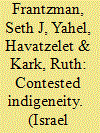

|
|
|
|
|
| Publication |
2012.
|
| Summary/Abstract |
The article examines the history of the development of a discourse that regards the Bedouin of the Negev desert in Southern Israel as an indigenous people of Israel. This movement has generated a great deal of activity in recent years, particularly the submission of a petition to the U.N. by activists asking for the Bedouin to be recognized as having indigenous communal rights in 2005. The subject is examined in the context of the worldwide recognition of indigenous rights that culminated in the U.N. Declaration on the Rights of Indigenous Peoples, which was adopted on the 13th of September 2007. The article takes account of the processes and activities of individuals who have helped lead and craft a narrative of an indigenous Bedouin identity. It also explores the rise of an indigenous consciousness movement as reflected in states, academic institutions, NGOs, and individuals across the world, with a focus on some of the implications for Israel and the region of the current struggle for recognition for indigenous rights.
|
|
|
|
|
|
|
|
|
|
|
|
|
|
|
|
| 2 |
ID:
114257
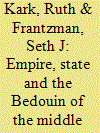

|
|
|
|
|
| Publication |
2012.
|
| Summary/Abstract |
The Bedouin of the Middle East have been one of the region's most marginalized groups in modern times. This study assesses the interplay between state policies and the Bedouin in the last 150 years, from a comparative standpoint. We examine the development of land laws in the Middle East as they have affected the Bedouin, from the enactment of the Ottoman land laws of 1858 up to the present. Moreover we explore whether the land laws and the fate of the Bedouin are associated with the characteristics of the regime in each country. We find that the imposition of land laws and policies directed at nomadic and sedentarizing Bedouins has depended on disparate factors such as the origins of the leadership of countries (i.e. Bedouin or non-Bedouin) and the social and economic models embraced. Regimes with origins in the tribal-Bedouin fabric of the Middle East have pursued land policies that were favorable to the Bedouin, whereas regimes drawing their strength from urban elites and with socialist outlooks encouraged very different policies. We also consider whether the case of the Bedouin in Israel is unique or reflects a larger regional context.
|
|
|
|
|
|
|
|
|
|
|
|
|
|
|
|
| 3 |
ID:
177573
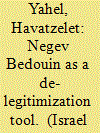

|
|
|
|
|
| Summary/Abstract |
This article explores the evolution of Bedouin international advocacy and discourse within UN human rights bodies, starting with the first in 1998 to present. It demonstrates that during the last two decades, Bedouin international advocacy in UN bodies was carried out by various NGOs with differing agendas. The discourse on Bedouin issues was co-opted by national and foreign NGOs, some of which possessed clear anti-Israeli views. Parallel to the increasing volume of Bedouin international involvement, their issues became an asset in the overall efforts to de-legitimise Israel. The Bedouin’s harsh living conditions and ongoing land conflict with the state assisted in portraying Israel as an apartheid state.
|
|
|
|
|
|
|
|
|
|
|
|
|
|
|
|
| 4 |
ID:
169984
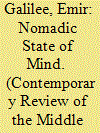

|
|
|
|
|
| Summary/Abstract |
This article is based on over a decade of field research among Bedouin tribes of the Negev as well as historical and geographical research. Its central argument is that the main social, cultural, and geographical processes within the Negev Bedouin groups are impacted by three major forces: nomadism and the social structure; formal Islam; and the rise of the modern state. This argument is illustrated by the geographical concept of “mental maps”, and its various manifestations in Bedouin society. The article focuses on the historical developments of the twentieth century, which took place alongside the rise of the Zionist movement and the establishment of the State of Israel.
|
|
|
|
|
|
|
|
|
|
|
|
|
|
|
|
| 5 |
ID:
164398
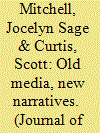

|
|
|
|
|
| Summary/Abstract |
In 1959, a Danish anthropological expedition to Qatar created hundreds of photographs and a 16-minute film depicting the diversity of Qatari lifestyles, which included strong evidence of a Bedouin past, separate from the merchant and pearl-diving culture of the coast. However, Qatar’s new national museum, still under development, has been working on a different narrative: a more unified national identity that emphasizes the similarities of Qatari heritage rather than the differences. Artifacts such as these photos and film can become inconvenient when they do not fit new and improved civic myths, yet as some of the most important (and well known) surviving images of Qatar’s heritage, this evidence cannot be left out. How might the museum make use of the evidence so that it aligns with its narrative? Here we focus on the aesthetic style of Jette Bang’s photographs and film, which emphasizes the warmth, hospitality, and universal humanity of Qatari heritage. Our argument connects the historical and ideological contexts for both the new national museum’s push for a unity narrative and Bang’s 1959 photographs and film. We suggest that the artistic elements of these ostensibly scientific and historical artifacts may offer Qatar’s new museum a way to repurpose them without jeopardizing a narrative of national unity.
|
|
|
|
|
|
|
|
|
|
|
|
|
|
|
|
| 6 |
ID:
177685
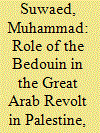

|
|
|
|
|
| Summary/Abstract |
This article focuses on the Bedouins’ part in the Great Arab Revolt in Palestine – during the time of the British mandate; what motivated some clans/tribes to join a given side, and why others chose to remain neutral – and it also refers to the later implications of these different choices. The article briefly overviews the social and political developments that led to the Revolt, explains the unique status of the Bedouin within the Arabic-speaking population in the area, and describes the internal diversity among Bedouin groups and the different alliances they made with the British Mandatory authorities and with other segments of the population.
|
|
|
|
|
|
|
|
|
|
|
|
|
|
|
|
| 7 |
ID:
183374


|
|
|
|
|
| Summary/Abstract |
Over less than a century, the majority of the once nomadic Bedouin of southern Israel were moved to live in towns that were established for them by the state, in the process of urbanization. These towns are far from satisfying the desires and needs of all the Bedouin. The rest of the Bedouin prefer to live outside the towns in a rural space. Based on archival sources the study reveals that the early policy supported the establishment of rural agricultural villages and transferring all Bedouin into fellahin (peasants). This policy was only later changed towards urbanization, a change that brought a problematic outcome. At the core of this study is an attempt to trace the reasoning that stood behind these policies and to make an analysis of their development and implementations
|
|
|
|
|
|
|
|
|
|
|
|
|
|
|
|
| 8 |
ID:
174143
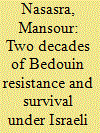

|
|
|
|
|
| Summary/Abstract |
Using archival data and newspaper collections from Britain and Israel, and extensive fieldwork interviews in the Naqab, this article breaks new ground through a critical examination of the Bedouin and their way of surviving and resisting Israeli military rule, 1948–1967. I argue that creative nonviolent resistance, everyday resistance and sumud (steadfastness and resilience), succeeded in modifying and mitigating the military rule strategies deployed by the state to control the Arab Bedouin, opening up the possibility of further political action and communal protection. By employing sumud as everyday resistance, the Bedouin improved their livelihood, strengthened one another and helped consolidate sumud, to the point where sumud became part of their culture and way of life during the military rule. Everyday sumud strategies were through border economy and contact with their relatives across the border, which utilized the strong relationships between tribes. Smuggling goods was a central form of economic survival and sumud. Everyday resistance and nonviolent actions succeeded in marginalizing military rules, restrictions, and power, allowing the Bedouin to gain immediate benefits including many of their daily needs. The Bedouin maintained their cross-border relations and continued to resist cooperation with the Israeli military rule. Hosting their fellow refugees was a daily act of sumud by the Bedouin despite the imposition of new state borders. The Bedouin also found different avenues to claim their dispossessed properties, and continued to resist Israeli confiscation of their land. They lodged land claims through every level of military rule, responding to different Israeli forms of power and the effect of domination.
|
|
|
|
|
|
|
|
|
|
|
|
|
|
|
|
|
|
|
|
|